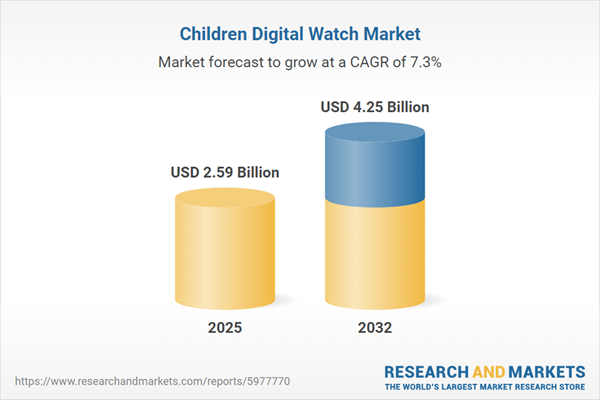Speak directly to the analyst to clarify any post sales queries you may have.
Senior leaders evaluating the children digital watch market are confronting a rapidly shifting environment influenced by advancements in connected technology, increasing regulatory complexity, and growing demands around institutional procurement. Effective adaptation in device sourcing, deployment, and compliance is essential for organizations striving to implement secure and efficient wearable solutions for youth populations and educational initiatives.
Market Snapshot: Children Digital Watch Market Overview
The global children digital watch market has entered a pivotal stage, supported by steady growth which signals enduring investment in digital wearable solutions. A compound annual growth rate of 7.32% highlights continuous organizational interest. Factors such as activity monitoring, enhanced safety features, and integrated educational applications are central to current sector dynamics. Both established enterprises and emerging brands are innovating in hardware and software design, increasing accessibility and enabling tailored offerings to support large-scale and specialized B2B acquisitions in diverse settings.Scope & Segmentation of the Children Digital Watch Market
- Product Types: Fitness tracker models enhance wellness program delivery within organizations; GPS-enabled digital watches advance safety oversight through real-time location capabilities; and smart home-compatible devices integrate seamlessly into broader digital ecosystems for both educational institutions and residential communities.
- Distribution Channels: Procurement spans specialty retailers, hypermarkets, direct manufacturer e-commerce, mainstream digital marketplaces, and direct selling, allowing institutions to select purchase routes that align with their acquisition protocols and volume requirements.
- Connectivity Technologies: Bluetooth (4.0, 5.0) ensures widespread compatibility; cellular connections (3G, 4G) facilitate robust, real-time communication; and dual-band Wi-Fi supports scalable management for single or multi-user program deployments.
- Price Ranges: The market features both entry-level and premium offerings, enabling organizations to choose between cost-efficient procurement for wide-scale rollouts or high-value devices tailored for specialized needs.
- Age Groups: Segmentation addresses requirements from preschool-age students through older cohorts, offering simple watches for younger children and interactive, wellness-focused variants for advanced educational programs.
- Regions Covered: Organizational strategies are optimized for the Americas, Europe, Middle East and Africa, and Asia-Pacific. The United States, Western Europe, and Asia-Pacific illustrate evolving procurement standards which drive global best practices and influence adoption trends worldwide.
- Key Companies: Sector leaders such as Huawei Technologies, Shenzhen Huayi Intelligent Technology, Garmin Ltd., Xplora Technologies AS, VTech Holdings, Fitbit, TickTalk, LG Electronics, Verizon Communications, and TCL Technology Group are central to innovation, supply continuity, and bespoke product solutions for institutional and B2B buyers.
Key Takeaways for Senior Decision-Makers
- Integrating children digital watches into youth programs enables improved engagement, efficient safety oversight, and more impactful learning outcomes for organizations aiming to expand or recalibrate technology-driven initiatives.
- Utilizing AI-powered analytics and comprehensive privacy safeguards cultivates organizational trust, meeting evolving standards for compliance in digital safety and data protection across educational and institutional segments.
- Flexible procurement—across multiple acquisition channels—supports rapid scaling, supports district-wide or pilot deployments, and aligns with dynamic program needs in public and private sectors alike.
- Strict alignment with regional compliance requirements enables smoother sourcing and lowers regulatory exposure in multi-jurisdictional technology rollouts, ensuring longevity and scalability for device programs.
- Forming partnerships among telecommunications, software, hardware, and education ecosystem participants enhances ongoing device value, promoting stable, effective implementation across organizational use cases.
- Prioritizing periodic security updates and up-to-date protocols protects institutional investments, addressing data breach risks and reinforcing regulatory compliance in continuing operations.
Tariff Impact and Strategic Response
Recent changes in United States tariff structures have prompted institutional buyers within the children digital watch sector to re-evaluate sourcing methods. Many organizations are increasing supplier diversity and renegotiating contracts to stabilize costs and delivery times. Collaboration with compliance experts and logistics providers is strengthening quality assurance as the market adapts to evolving international trade and regulatory landscapes.
Methodology & Data Sources
This market assessment draws upon executive and developer interviews as well as regulatory feedback to provide balanced insights. Analyses from industry reports, curated datasets, and patent filings support a thorough, data-driven perspective for procurement and deployment decisions relevant to the children digital watch sector.
Why This Report Matters
- Provides actionable market intelligence to help senior leaders refine procurement workflows, align technology with strategic needs, and drive stronger program delivery across institutional contexts.
- Helps organizations navigate regulatory changes, optimize complex supply chains, and recognize new commercial opportunities at both global and local levels as the sector evolves.
- Promotes robust risk mitigation and business resilience by encouraging cross-industry collaboration and facilitating technology adoption approaches customized to institutional program goals.
Conclusion
Adaptive leadership ensures organizations remain ahead as technology trends, compliance needs, and procurement standards shift in the children digital watch market. Proactive planning delivers ongoing success and reliable partnerships in this rapidly evolving sector.
Additional Product Information:
- Purchase of this report includes 1 year online access with quarterly updates.
- This report can be updated on request. Please contact our Customer Experience team using the Ask a Question widget on our website.
Table of Contents
3. Executive Summary
4. Market Overview
7. Cumulative Impact of Artificial Intelligence 2025
Companies Mentioned
The companies profiled in this Children Digital Watch market report include:- Huawei Technologies Co., Ltd.
- Shenzhen Huayi Intelligent Technology Co., Ltd.
- Garmin Ltd.
- Xplora Technologies AS
- VTech Holdings Limited
- Fitbit, Inc.
- TickTalk, Inc.
- LG Electronics Inc.
- Verizon Communications Inc.
- TCL Technology Group Corporation
Table Information
| Report Attribute | Details |
|---|---|
| No. of Pages | 185 |
| Published | October 2025 |
| Forecast Period | 2025 - 2032 |
| Estimated Market Value ( USD | $ 2.59 Billion |
| Forecasted Market Value ( USD | $ 4.25 Billion |
| Compound Annual Growth Rate | 7.3% |
| Regions Covered | Global |
| No. of Companies Mentioned | 11 |









